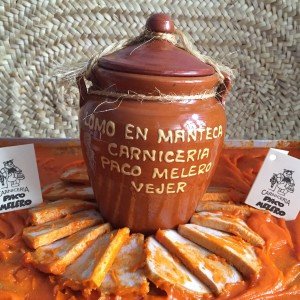The A-Z of Must-try Costa de la Luz Food & Drink
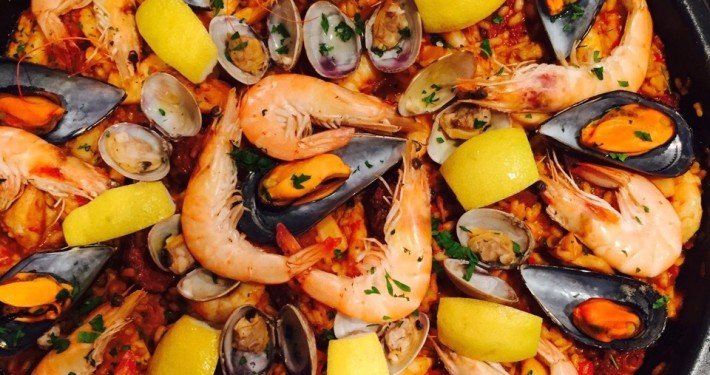
As is the case with any great food culture, there’s a lot to get your head around with Spanish food. To help you explore the gastronomic ins and outs of the Costa de la Luz, I’ve put together an A-Z list of Spanish food names (with perhaps the odd local wine thrown in for good measure) that you’ll find on your travels down here.
A – Almadraba
The Almadraba is the traditional harvest of the blue fin tuna (atún rojo) as they migrate from the cold waters of the Atlantic to spawn in the warmer waters of the Med (end April – beg June).
This ancient and sustainable method of catching tuna dates back to the Phoenicians. When you see Atún Almadraba on a menu, expect to pay a price premium. The blubber the fish build up in the cold Atlantic permeates the flesh thus giving it a melt in the mouth quality. Its unrivalled quality can be compared to the divine fat of the Iberian pig. The tuna are frozen at -60 degrees after butchering, making it available ‘fresh’ all year round. I now offer a 4 night food adventure dedicated to The Almadraba and Blue Fin tuna
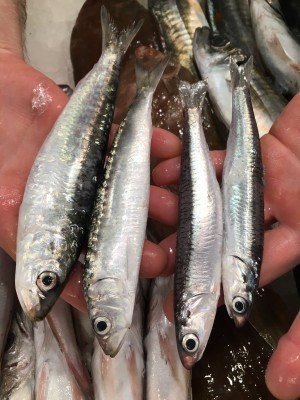 B – Boquerones (anchovies)
B – Boquerones (anchovies)
Fresh, they are boquerones. Fried, boquerones fritos. Pickled, boquerones en vinagre. Salted and cured, anchoas. The best anchoas come from Cantabria in the very north of Spain. Look out for tapas of anchoas and boquerones together. Or just anchoas, on their own, atop a slice of local cheese (queso de Payoyo) or with sliced tomatoes and onions with olive oil. However they come, though, they’re always delicious. Especially when you have a chilled glass of Fino or Manzanilla in your other hand!
C – Cephalopods
Cephalopods form the bulk of most menus here. In decreasing size order the family members are:
- Pulpo (octopus)
- Choco (cuttlefish)
- Calamar (squid)
- Chipiron (small squid)
- Puntillita (tiny squid)
Each family member is independent i.e. a puntillita will never grow to become a calamar. They all squirt ink at their predators – this ink giving the lusciousness to arroz negro and croquetas de choco/sepia. Depending on how they are cooked, they are low in fat but high in cholesterol. I love all cephalopods cooked in all manners.
D – Desayuno (breakfast)
Here in La Janda region breakfast means one of three things: tomate, mermelada or manteca – on toast (tostada) of course. Medio or entero – whole or half of a torpedo roll, mollete or pan de campo (workers’ bread). My fave is mollete. After the classic pan con tomate y aceite, always with a sprinkle of salt on top. Mermelada, is not marmalade, it’s jam. You will find that mermelada de melocotón (peach) is the most typical around here since Seville is renowned for the beautifully sweet peaches it produces during the summer months. Look out for La Vieja Fábrica brand – it’s truly the finest. Finally there’s manteca colorada (Iberian pork fat ). I know what you might be thinking; however, the fat used here comes specifically from the Cerdo Ibérico (Iberian pig), whose purely acorn diet produces a fat rich in healthy Omega 3 oils, like fish oils. It’s therefore healthier than your average butter, but oh so much richer. As a good Australian friend living in Vejer puts it: the British grow up with buttered toast, the Aussies with Vegemite on toast, and the Spanish, pork fat on toast.
E – Erizos (sea urchins)
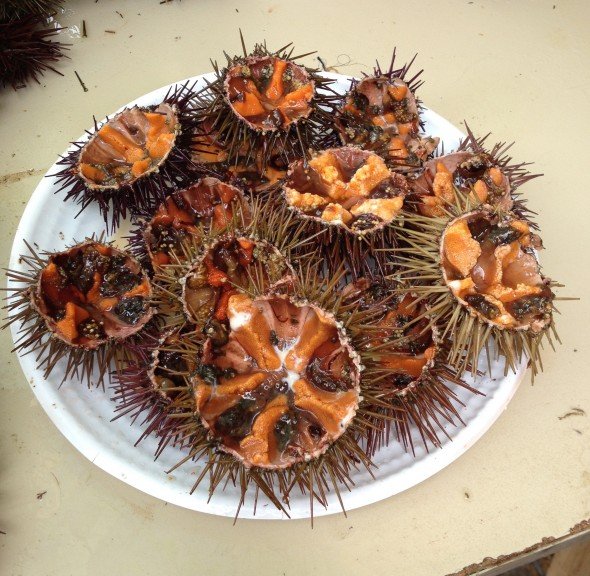
Seasonal and spiky, they are cracked open and eaten raw with a spoon. Perhaps with a squeeze of lemon, too. Street vendors appear on Cadiz street corners selling them during the cooler peak months of January and February – although they can still be found until April. Preserved in tins, they are often used for croquetas.
F – Fino (young, dry Sherry)
The youngest and driest of all Sherry wines, Fino can only come from the towns of Jerez and El Puerto de Santa Maria. The Fino style from Sanlúcar is called Manzanilla. Fino is best served chilled alongside anything salty such as olives or fried fish. 100% Palomino grape, it is aged using a fractional blending system called Solera and Criadera and constantly protected from the outside oxygen from a layer of living yeast called ‘Flor.’ The perfect match for all salty and fishy foods. Amazingly both are a great match to a piece of 72%+ dark chocolate!
G – Gambas (prawns)
You will find LOTS of prawns here. The best are the gambas blancas from the Huelva or Sanlúcar areas. They are pale pink, not grey, when raw. Best submerged in a pan of boiling water for two minutes, then refreshed under cold water to stop the cooking process. Gambas Ajillo (garlic and prawns cooked in olive oil) is a typical delicious tapas/starter dish.
H – Hierbabuena (mint)
Although found in every fruteria, it is rarely used in cooking – a couple of leaves in a gazpacho or perhaps mixed with parsley and garlic for stuffing into braised artichokes. However, Mojitos are everywhere. Ask for a handful of it whenever you are making purchases at any fruit and veg stall.
I – Ibérico
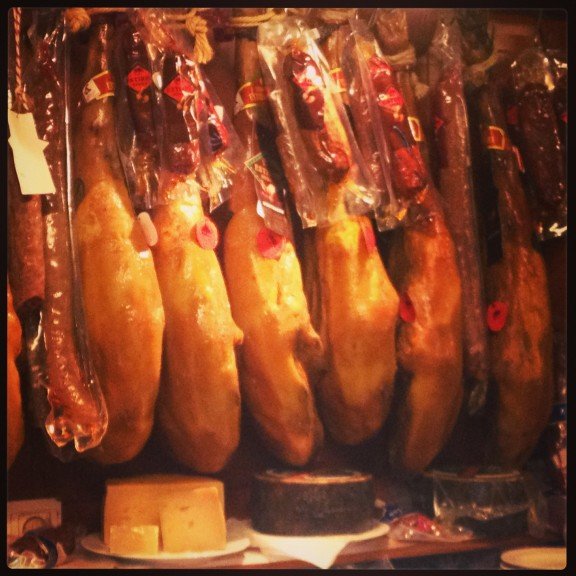
Ibérico is the name given to the pork products from the acorn-fed Cerdo Ibérico or Pata Negra. It’s the acorns that give the pork its unique flavour and succulence. Acorns are full of oleic acid, the same as Extra Virgin Olive Oil, so the fat from the Cerdo Ibérico is regarded as healthy fat. Look out for Jamón Ibérico and Chorizo Ibérico. And for cooking on your plancha or BBQ, Presa Ibérica and Secreto Ibérico. Keep an eye out for atún en Manteca Ibérica (tuna preserved in fat from the Iberian pig), found at the Herpac tuna preserve shop in Barbate. Serrano ham is from the pink pig fed on normal pig food so it does not offer the same healthy qualities. The price of Jamón Ibérico will reflect how many months the pig has been fed on acorns. It can range from €100-€200 a kilo. Serrano can start around €20 per kilo.
J – Jamón Ibérico
Iberian pigs are left to run free and gorge themselves on acorns (eating up to 25 lb each a day) during the montanera – the period when acorns abound. On reaching 160kg, the pigs are put to sleep then slaughtered (if the animals are stressed the meat would spoil). Once butchered, the back and front legs are cut from the pigs and trimmed, leaving 2cm of fat. The joint is then stored for three weeks in mounds of Atlantic sea salt. Washed, it spends 24-30 months drying in the vast bodegas. The air in Jabugo is pure, cold and dry by day, but humid at night. This causes a unique mould to grow on the ham, adding its own flavour to the meat. The ham is sweet, rich and nutty, with a seductive creamy fat. Jamón refers to the back leg; paleta, the front leg. The front leg (paleta/shoulder) generally has more fat and as fat is king here, it can be the more popular, although cheaper cut. Read more about the production of fabulous Jamon Iberico here
K – K-naia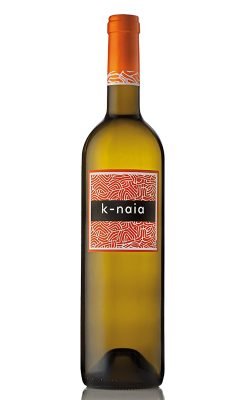
A Verdejo from the Denominación de Origen (DO) of Rueda. Until recently the only white wine by the glass offered in bars would be the local Barbadillo or Tierra Blanca made from the main Sherry grape called Palomino. And then along came Verdejo from the northern DO of Rueda. DO in Spain is similar to AC (Appellation Controle) in France. Verdejo is young, fruity and delicious. Although K-naia (Bodegasnaia.com) is not my absolute favourite, it is still very quaffable.
L – Luz (light)
The western part of the southern coast stretching from Cádiz to Huelva, known as the Costa de la Luz, is famous for its light and receives more than the average amount of sunlight in the Mediterranean. Facing out to the Atlantic, this stretch of coastline encompasses an ample variety of breath-taking towns, including Vejer de la Frontera, Medina Sidonia and Sanlúcar de Barrameda. Each town has its own identity with raw history, left behind by the Phoenicians, Jews and Moors, protruding from all corners. It is a stunning section of coastline that has not been subject to the excess, budget tourism that many parts of Costa del Sol has seen. The food on offer along the coast remains authentic to the region and some of the restaurants here are some of the best places I have eaten. This really is a photographer’s and artist’s dream location.
M – Mojama (air-dried tuna)
Tuna jerky. An ancient method of preserving the seasonal tuna. Unique to this area of traditional tuna fishing, Mojama is sometimes known as “Jamón of the sea”. The cuts of tuna undergo the same curing process as Jamón – first the salt and then air drying. Sliced thinly and then drizzled with a splash of olive oil (not extra virgin as too strong). A perfect match with a glass of chilled fino or a beer (cerveza). Try this recipe when you’re here
N – Navajas (razor clams)
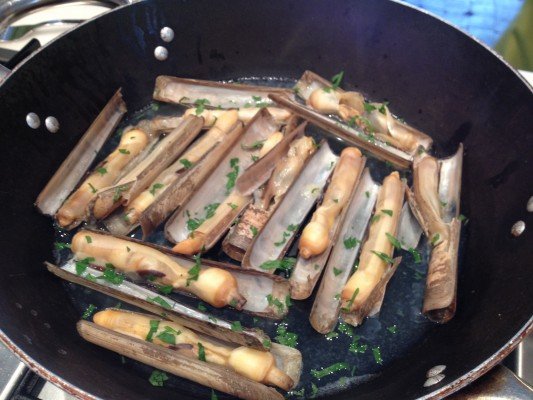
These shellfish are a delicacy here. Buy fresh from the fish market and discard any broken ones. Rinse under cold running water to clear of any sand and then add to a preheated frying pan. As they begin to open, squeeze over lots of fresh lemon juice. Perhaps add a sprinkle of parsley. They’re beyond delicious when accompanied by a glass of Manzanilla and lots of bread to soak up the cooking juices.
O – Oloroso
On the scale of Sherry varieties, from crisp and dry Fino and Manzanilla to rich and sweet Pedro Ximénez, Oloroso appears further down the list. Its unique quality is that it is the only dry Sherry that is completely oxidised right from the start of its life. This is precisely what gives it its dark mahogany colour. My guide to matching Sherry and tapas points out that when matching Sherry, ‘If it runs – Oloroso.’ It therefore complements Queso de Cádiz, Jamón Ibérico, all local cuts of pork such as Presa, Secreto, Lagarto and Pluma and all Retinto burgers and steaks exquisitely. Oloroso takes on an additional role when added to Pedro Ximénez to produce another variant of Sherry called ‘Cream,’ typically paired with local desserts.
P – Pescados Fritos (fried fish)
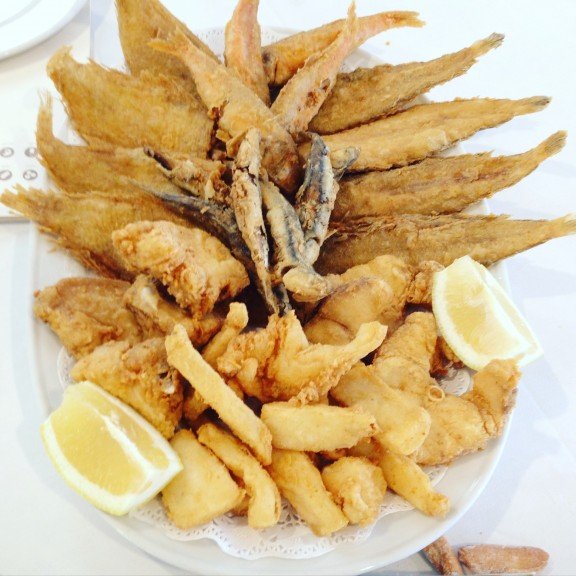
Let’s just say you have majorly sinned if you leave the Cádiz province without tucking into a plate of pescados fritos that is so typical around here. The fish served to you will vary from place to place, depending on the catch that day, so it is indeed some of the freshest fish you can eat. Despite its various forms, look out for chocos (cuttlefish), calamares (squid), puntillitas (baby squid), cazón en adobo (marinated firm fish), acedia (member of the sole family), boquerones (fresh anchovies) and ortiguillas (sea anemone). Last but not least, las tortillitas de camarones (lacy, crispy prawn pancakes) really are a must and, from experience, are best devoured in Sanlúcar de Barrameda, Cádiz and Puerto de Santa María. Sampling these delights with a glass of Manzanilla is the perfect maridaje (matching) of local wine and food from the province. Here’s where to eat them in Cadiz
Q – Quesos de Cádiz
Cádiz province maintains a strong heritage for artisanal cheese (note: mostly hard). Most famous is Queso Payoyo elaborated in Grazalema and Villaluenga del Rosario. This cheese champions the milk from the Payoya goat, which is extracted in an entirely ecological manner. El Bosqueño goat’s cheese from El Bosque is also elaborated by traditional artisanal methods and matured in numerous ways: in olive oil, Iberian pork fat, chilli and in rosemary (just like breakfast!)
R – Retinto
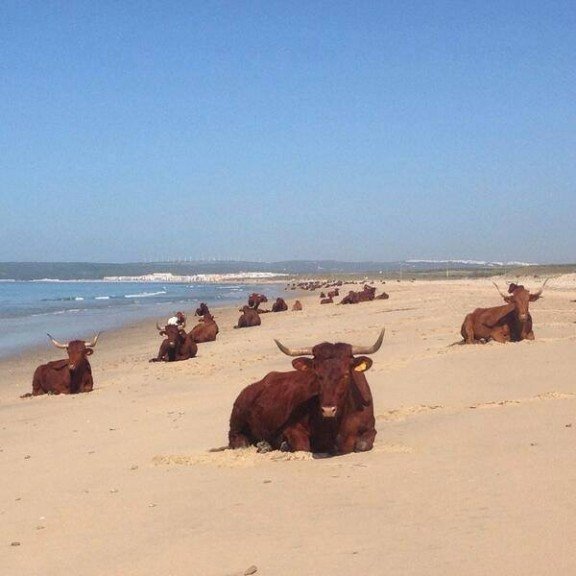
There are two types of meat that are worshipped in this region: Iberian pork and beef. Again we’re talking about a breed unique to this pocket of Andalucia, that hail from the Retin hills behind the coastal town of Zahara de los Atunes. Retinto cows live outside all year round and enjoy a diet of dried herbs and scrub during the summer and lush pastures following the rains in winter. They’re a funny lot, identified by their reddish-brown colour, and can often be caught sight of on the beach! The locals claim that their exposure to the salty sea air and their pure earthy diet means their meat comes already seasoned.
Whilst here, do sample the diversity of Retinto dishes on offer, like entrecote, carpaccio and Retinto burgers. Or buy it fresh to barbecue from our favourite butcher, Paco Melero. Each September, Zahara los Atunes holds a local Ruta del Retinto (Rutadelretinto.com) in celebration of the Retinto Beef (similar to the spring Ruta del Atun) – where the bars and restaurants compete to produce the best tapa using the local beef.
S – Sherry Triangle
Whilst there is so much to be learnt about the beautiful journey Sherry goes through in its elaboration, a good starting point is that Sherry can only be produced in this part of the world, the region of Cadiz. Sherry has to age within the borders of Jerez de la Frontera, Puerto de Santa María and Sanlúcar de Barrameda. Draw a line to join up these 3 towns and you will have the Sherry Triangle. Similar to A.C.of Champagne in France, other sparkling wines can’t be called champagne if they are produced outside the AC of Champagne. Sherry can only be called such if produced within the Sherry Triangle. (Check out my beginner’s guide to Sherry here.) There is no better example of a wine that is made to match the food of an area than Sherry with the food of Cadiz.
T – Tangiers
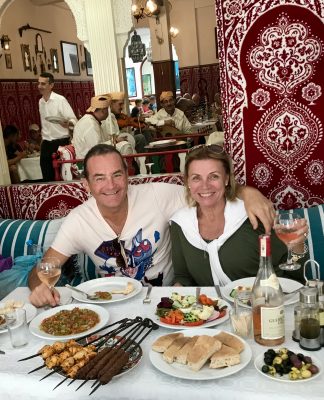
Lunch in Tangiers
I really do adore Tangiers. I find it fascinating that within 90 minutes of leaving my front door I am transported into another world (and time zone – GMT). Mint tea, amalou, sticky nougat, cumin, walnuts, juicy dates, harissa, olives, orange flower water… the diverse sights and smells are mind-blowing, and it never fails to excite me whenever I make the trip. The medina is a shopaholic’s heaven: I can never avoid returning to Spain laden with new mugs, plates, spices, olives, pots, and even rugs. I have built up a thorough knowledge of Tangiers through my thirst to explore new restaurants and cafés in the city and I have been so inspired by the food there that I now offer a 4 night Moroccan cookery course which includes spending a day in magical Tangiers. I have been working with local guides for years and can therefore assure you will be given this authentic experience when you book one of my day trips to Tangiers
I’m so in love with Morocco that I now offer a 9 night culinary tour of Imperial Cities. We start with 2 nights in Tangiers.
V – Vinagre de Jerez (Sherry vinegar)
As you might expect, this is the vinegar elaborated from the traditional Solera and Criadera system used to produce Sherry. It’s unique to the region and also protected by the DO Jerez. Vinagre de Jerez is the gourmet vinegar used to further enhance the fabulous dishes and ingredients of this area. This is the only kind I use in my kitchen. It marries beautifully with the local juicy tomatoes and is a staple when preparing gazpacho. So ditch that balsamic stuff when you arrive, here Sherry vinegar takes pride of place.
Zzzzzzz
If you’ve got this far then you probably do need a siesta! Siesta time (approx. 2-6pm) covers lunch and a snooze afterwards, ahead of re-igniting around 6pm, until the call to tapas at 9pm. The hours of siesta are sacred in Andalucia and need to be observed and respected. Minimal noise please as during summer, even the children sleep so that they can party during the cool evenings.
10 things you have to eat when in Vejer:
And if I had to break my A-Z list down to just 10? With some sadness at the ones I’d have to leave behind, these would be my pick of things that you absolutely must eat when you’re in Vejer de la Frontera:
- Mojama
- Anchoas y queso
- Payoyo (goat’s cheese)
- Presa and Secreto Ibérica/o
- Lomo en manteca
- Atun de Almadraba
- Pan con tomate
- Carpaccio de Retinto
- Pescados fritos
- Alfajores de Medina Sidonia
(Washed down, of course, with a glass or two of Sherry.)
Like this A-Z list of Spanish food names that you’ll come across down here on the Costa de la Luz? Find out more about the fabulous local food scene on one of my cooking courses.


